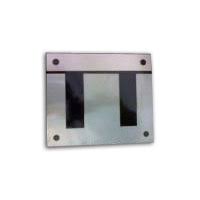When we use the equation VpIp = VsIs we are assuming that the transformer is an ideal transformer. An ideal transformer is one which is 100% efficient. In practice, the efficiency of a transformer is less than 100%.
A transformer is designed so that as little energy as possible is lost. There are many ways that a transformer can lose energy.
(a) Power losses occur because the changing magnetic field will also induce currents in the iron core. These induced currents are known as eddy currents. Eddy currents will generate heat and reduce the transformer's efficiency. In order to reduce the formation of eddy currents, a laminated core is used.
(b) Current flowing through th primary and secondary coils will generate heat. Low resistance copper wires is used to reduce this effect.
(c) The core is magnetised and demagnetised alternately when AC current flows through the primary coil. Energy is lost during this process. This is known as Hysterisis. This effect is reduced by using a soft iron core.
(d) There may be a leakage of magnetic flux in the primary coil. A special core design is used in a transformer to ensure that all the primary flux is linked with the secondary coil.
